Starting backwards, with the Architecture of Dance festival at the New York City Ballet this season, the seven choreographers all had the option to commission a score, as well as a set by no less than famous Spanish architect Santiago Calatrava, for their world premieres. With one ballet to go, I’m beginning to suspect this embarrassment of riches may be more embarrassment than riches– that there’s only so much a choreographer can respond to before he loses focus. Is it an accident that the best pieces in the festival have tended to forego commissioned score or Calatrava set, or both? Did Wheeldon, Ratmansky, and McGregor all know better than to overwhelm themselves with so many choice elements that demand a piece of the action? The problem may just be timing: that when you have a commissioned score or new large sculpture to get used to, it never arrives early enough. Anyway, the record so far has been that those who used a commissioned score (Millepied, Barak, and Bigonzetti) made wretched ballets. The Calatrava sets did less harm, though not much good either. Maybe Peter Martins, with commissioned Calatrava movable set but extant score, will disprove the rule. His ballet premieres Tuesday.
Update: Yup, the Martins ballet, Mirage, did disprove the rule. Yippee! Martins has turned out so many dutiful, empty ballets that I wasn’t expecting much. It is lovely to be proven wrong–to witness a choreographer overtaken by curiosity.
Here is the start of my review, which came out today (Friday 6/25) in the Financial Times:
Until this week, the New York City Ballet’s Architecture of Dance festival was proving a disappointment, despite the creative expenditure: four commissioned scores for seven new ballets and the world-renowned architect Santiago Calatrava at the ready to design sets.
The Spaniard’s organic shapes suit the ballet stage, and yet the choreographers either had him painting backdrops – lovely, sure – or treated his poetically charged structures as if they were backdrops even when they dominated the space. Meanwhile, the scores seemed to thwart more than inspire.
Peter Martins’ Mirage comes as a relief, then, if not a vindication. The dance, the airy set that rises from the ground to hover like a massive bird, Esa-Pekka Salonen’s restless violin concerto and Marc Happel’s costumes in muted colours and curving lines cohere into a single sensual, meditative work tinged with melancholy.
Robert Fairchild beside Katherine Morgan in one of several entrancing duets beneath the big wire bird/divided heart. Fairchild danced with a beautiful gluiness (in duet with Anthony Huxley; in the coed pas de deux, the men don’t move much, mainly providing a core for the women ). Morgan demonstrated the most delectable timing for her swooping legs. Photo by Paul Kolnik for NYCB.
The steps correspond to the set’s white cords, which twist to converge at its spine. Mirage gyres, with moves winding and unwinding from the body’s and the stage’s central axis like a string with a weight at its base. Robert Fairchild and Anthony Huxley throw a leg across their torsos that sends them into a long spiral of off-kilter turns. Kathryn Morgan alternates lunges that catapult her forward with ones that throw her back, her leg a pendulum – slowest at its extreme, swiftest and most powerful as it returns to neutral. When the bird overhead closes its wings to become a heart, Jennie Somogyi makes Jared Angle her compass and the leg scalloping the air its guide.
The crescendos and decrescendos that weight and momentum dictate combine with…
For the rest of the review, click here.
As for earlier, less succesful efforts (end of update) here is the start of my review for the Financial Times of the Bigonzetti premiere:
This year, the new choreography festival at New York City Ballet mainly involves old hands. Alterballetto’s Mauro Bigonzetti, for example, is on to his fourth ballet with the company. In an interview printed in the programme, he says he knows the dancers well enough by now to make “their character and humanity” his inspiration.
So why, in Luce Nascosta (“Hidden Light”), do they resemble bugs? And the goons in Balanchine’s Prodigal Son, and marionettes – anything but humans? And why is one dancer indistinguishable from the other?
The blame rests in part with the gloomy lighting – a favourite of choreographers from sunny Italy – and the identical black costumes for the nine women (midriff and ruffled floppy tutu over bare legs) and nine men (karate trousers, with chest bare). But the larger problem is the elaborate lexicon of meaningless quirks the choreographer has devised. It obscures the dancers’ individual gifts.Hands splay like cut-out stars. Hip-hop gesticulations circle head and shin. Rumps protrude and spines spasm out. Limbs snap straight then retract like those of a cartoon bug on its deathbed. In tangled pas de deux, the woman inserts her legs into the nooks and crannies between her body and his.
Adrian Danchig-Waring and Teresa Reichlin get squiggly and spiky. Photo by Paul Kolnik for the New York City Ballet.
The dancers each have their moment in the gloom. And, yes, Maria Kowroski’s cameos are not identical to Ashley Bouder’s. Kowroski’s phrases tend to unfurl in a single long breath; Bouder’s are staccato. But by the time one dancer has followed another and another and another, the predictability of the ballet’s structure overwhelms any surprises….
For the whole review, click here.
And here begins my Financial Times review of the more complete and more interesting festival fiasco, Call Me Ben:
It must have seemed nifty to put the wunderkinds together – choreographer Melissa Barak, 30, whose first piece the New York City Ballet staged when she was 22, and Jay Greenberg, 18, who by the age of 12 had composed five symphonies, the last of which the London Symphony Orchestra performed. But Call Me Ben, about 1940s gangster Ben “Bugsy” Siegel, is a disaster.
The gangsters object to Daniel Ulbricht’s orders. Photo by Paul Kolnik for the New York City Ballet.
The problem begins with the commissioned score. Bouncing fast from Shostakovichian bombast to Prokofiev-style dissonance to generic symphonic syrupiness, the music does not lend itself to anything but listening. But Barak’s ballets – among them, three previous works for NYCB, her alma mater – have adhered to the Balanchine rule of letting the music set the terms. So she meets musical mishmash with her own hodgepodge. The bio-ballet pairs homemade dialogue that erratically advances the plot – and is delivered woodenly by panting, overmiked dancers – with intervals of dancing that reveal nothing about the characters.Barak’s choice of story demonstrates an excellent instinct for drama…..
For the full takedown, click here.
Meanwhile downtown, the Martha Graham Company wowed me with early work by both Graham and her contemporaries. Imagine abstraction coming into being before your eyes.
I have to confess, I have been a reluctant joiner to the Graham camp. In the early 2000s, when the company’s future was in jeopardy, I privately thought, Let it go: it can’t be saved. Imagine a modern dancer version of Funny Face‘s bohemians and psychoanalysts, and you’ll have some idea of the grotesquerie that the Graham dances had become. But then former Graham star Janet Eilber took over, and restored the work by scraping off all the later “touch ups”: finally I could see what the big deal was. Now she has extended that clarity to Graham’s 1930s peers.
This group of works makes up The Political Dance Project, but it’s the formal radicalism in the service of these politics that is especially amazing.
Here’s a chunk of my Financial Times review from a couple of weeks ago:
Janet Eilber, artistic director of the Graham troupe since it returned from the brink a few years ago, is the kind of thoughtful contrarian that the maverick choreographer would have appreciated. According to the dance world’s conventional wisdom, a historic work can speak so loudly for itself that the present will not drown it out; Eilber, on the contrary, insists on context and curation.
This season’s Political Dance Project honours Graham’s belief that “no artist is ahead of his time, he is his time”, by setting the works of her early, all-female group beside their contemporaries. The effect is to illuminate the Graham pieces or modern dance between the wars, and the whole modernist project.
Isadora Duncan’s 1924 solo The Revolutionary lends strange forms and new meanings to the iconic fists and lunges of the revolutionary worker. Tadej Brdnik plants his knuckles on the ground as if to drill into the red earth. But then his arms plié and a diamond of negative space appears. Whatever you thought the fists signified is suddenly – and happily – confounded.
Brdnik the revolutionary. Photo by Kerville Cosmos Jack.
In 1938 and a mesmerising Carrie Ellmore-Tallitsch performed on Wednesday, also converts archetypal forms into poetic abstractions. The concave chest, scuffling walk and furtive gaze of the down and out become a bright mechanical bird.
This alchemising process seems to be a defining element of early modern dance. A gesture acquires sculptural heft and escapes the commonplace.
In Graham’s 1936 Chronicle, this occurs via hands and arms that…
For the whole review, click here.
American Ballet Theatre is stitching up the hole that the Joffrey Ballet’s move to Chicago fifteen years ago caused in New York’s Ashton rep–and it’s a wonderful thing. This year ABT added Birthday Offering and the Thais pas de deux to Sylvia and The Dream. Next up Monotones?
You still have a couple more chances to catch the Ashton program the last week in June. Here’s the start of my Ashton review for the Financial Times:
Frederick Ashton’s particular genius is not easily assimilated into New York’s ballet scene. New Yorkers expect race horses – limbs splayed, space devoured. Ashton offers show horses, the dancers moving up and down, all head and jittery feet. His heart is too warm to make ours ache the way Balanchine can. And though Ashton seems no more European than Jerome Robbins – no angst themes or chiaroscuro lighting – he doesn’t compensate for his lack of suavity with streetwise cool: the ballets do not point outward to the world but inward to ballet and its pagan-pastoral past. Even Ashton’s fondness for imperial Russian style, with which we are also in love, does him no favours. In his hands, it becomes neither imperial nor Russian but a gently parodic version of ballet itself.
Nevertheless, and happily, American Ballet Theatre has expanded its Ashton offerings beyond Sylvia and The Dream, in which the glorious storytelling and brilliant characterisations mitigate the foreignness of the style.
The 1956 Birthday Offering distils The Sleeping Beauty down to its fairy variations. Isabella Boylston, for example, is the Carmen fairy – her legs stabbing the ground and slicing through the air. Stella Abrera moves with the Lilac Fairy’s pillowy softness, swinging a leg as if chiming a bell. All seven ballerinas halo their heads in their arms with such a sweetly self-conscious air that they momentarily turn into ballerina dolls.
For the 1971 Thaïs pas de deux, Ashton kaleidoscopes the various incarnations of La Bayadère‘s Nikiya – from full-blooded temple dancer to vengeful ghost. Even after removing her veil, Diana Vishneva averts her gaze as if she were lost from this world. But her exposed neck suggests that the other world is her willing body.
Diana Vishneva and Jared Matthews in Ashton’s meditation on Massenet’s Thais.
On Tuesday the audience responded tepidly to these plotless works. They might have been more enthusiastic if ….
For the whole review, click here.
And now for something completely different, which I couldn’t do justice to in my tiny review: John Jasperse’s Truth, Revised Histories, Wishful Thinking and Flat Out Lies, at the Joyce through Saturday (June 19). If the magical work is all about piecing things together–wildly disparate things, such as striptease and cartoon gangsters and dandy summers in Tom Wolfe white with string quartets, and floridity and glamour and wallpaper–how is it that the dance ends up such a whole, one that implausibly is the culmination of its manifold moods? Truth concludes with quiet and melancholy and, dare I say, what feels like truth, after all the trapdoors and hapless tricks.
Here’s the first bit of my Financial Times review today:
John Jasperse is a wily artist. He dubs his latest work Truth, Revised Histories, Wishful Thinking, and Flat Out Lies in a nod to the flood of book-length exposés with run-on, tell-all titles. And yet this two-act absurdist tragicomedy makes such a glorious muddle of its own investigation that you almost forget there is one until the end, when a clue appears like a reticent guest.
John Jasperse points the finger–or arrow, as it happens; Erin Cornell tries to slither out of the way. Photo by Sylvio Dittrich.
Jasperse, 46, is one of the few American post-Boomer experimental choreographers to achieve some renown. He tours not only in western Europe but also in the US, and not only to the coasts but also in between. As much an auteur as Pina Bausch, he is less inclined to knit the elements of theatre into a ritualistic whole than to dismantle them so as to link the workings of theatre to those of the world: the “War on Terror”, the stultifying effects of the family, and now truthiness – as the political satirist Stephen Colbert would say. Jasperse’s riskiest and freest work to date, Truth etc amounts to a deranged pastiche of borrowed movement – the choreographic equivalent of cheating, if not lying.Captivating Erin Cornell gives a drunken turn to Twyla Tharp’s ragdoll style. Cornell and Jasperse, the show’s drifting MC, stage a slow-mo kung-fu tussle that ends in a real slap. Eleanor Hullihan and Cornell perform a topless number that combines the affectlessness and self-stroking of the professional stripper with the affectless and planar geometries of postmodern dance. Meanwhile….
For the whole review, click here.

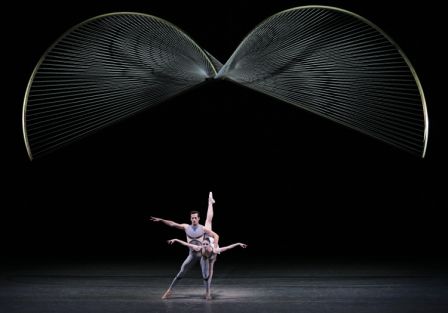
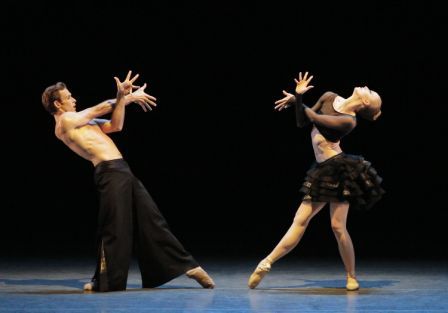
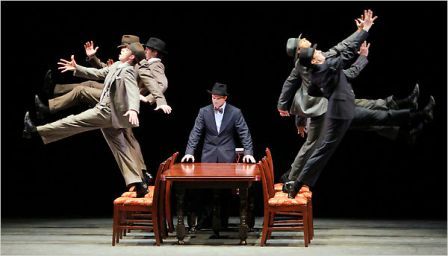
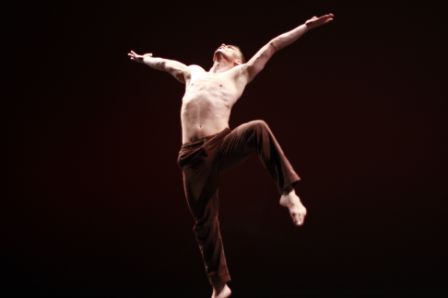
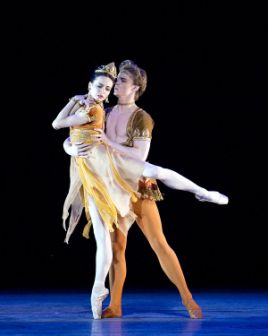
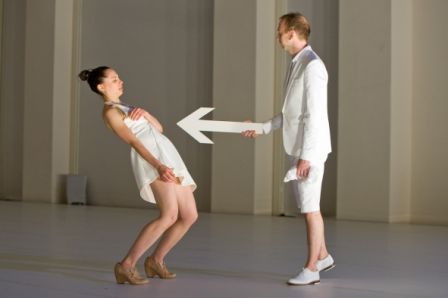
Leave a Reply